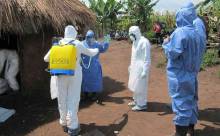
Questions and Answers on Ebola
The current Ebola outbreak is centered on three countries in West Africa: Liberia, Guinea, Sierra Leone, although there is the potential for further spread to neighboring African countries. Ebola does not pose a significant risk to the U.S. public. The CDC is surging resources by sending 50 more workers to the area to help bring the outbreak under control.
What is Ebola?
Ebola virus is the cause of a viral hemorrhagic fever disease. Symptoms include: fever, headache, joint and muscle aches, weakness, diarrhea, vomiting, stomach pain, lack of appetite, and abnormal bleeding. Symptoms may appear anywhere from 2 to 21 days after exposure to ebolavirus though 8-10 days is most common.
How is Ebola transmitted?
Ebola is transmitted through direct contact with the blood or bodily fluids of an infected symptomatic person or though exposure to objects (such as needles) that have been contaminated with infected secretions.
Can Ebola be transmitted through the air?
No. Ebola is not a respiratory disease like the flu, so it is not transmitted through the air.
Can I get Ebola from contaminated food or water?
No. Ebola is not a food-borne illness. It is not a water-borne illness.
Can I get Ebola from a person who is infected but doesn’t have any symptoms?
No. Individuals who are not symptomatic are not contagious. In order for the virus to be transmitted, an individual would have to have direct contact with an individual who is experiencing symptoms.
http://www.cdc.gov/vhf/ebola/pdf/ebola-qa.pdf
Fonte: CDC
